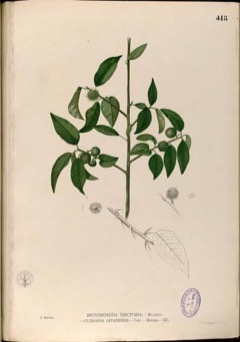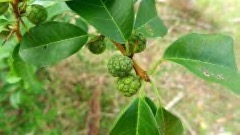 |
|
http://www.edibleplants.org |
 |
| John Tann Wikimedia.org |
Translate this page:
Summary
Cocksure thorn or Maclura cochinchinensis is a slow-growing thorny vine native to China, Malesia, Queensland, and New South Wales. The stems grow up to 10 m long and up to 15 cm in diameter. The thorns are present on the nodes. It has been popularly used in ‘batik’ processes in Indonesia. The leaves are oblong and arranged alternately. The fruit is hairy, round, and green but turns yellow-orange as it ripens. The young leaves and fruits can be eaten. The wood is used to treat fevers while root decoction is used against coughs. The heartwood yields yellow dye that is used as an ingredient in traditional ‘soga-batik’ when mixed with other dyes.
Physical Characteristics

 Maclura cochinchinensis is an evergreen Shrub growing to 10 m (32ft) by 8 m (26ft) at a slow rate.
Maclura cochinchinensis is an evergreen Shrub growing to 10 m (32ft) by 8 m (26ft) at a slow rate.
See above for USDA hardiness. It is hardy to UK zone 10.
Suitable for: light (sandy), medium (loamy) and heavy (clay) soils. Suitable pH: mildly acid, neutral and basic (mildly alkaline) soils. It cannot grow in the shade.
UK Hardiness Map
US Hardiness Map
Synonyms
Cudrania cochinchinensis (Lour.) Kudo & Masam. Cudrania javanensis Trécul. Maclura javanica Blume. V
Plant Habitats
Edible Uses
Edible Parts: Fruit Leaves
Edible Uses:
The young leaves are sometimes eaten raw[310 ]. The fruit is edible[310 ].
References More on Edible Uses
Medicinal Uses
Plants For A Future can not take any responsibility for any adverse effects from the use of plants. Always seek advice from a professional before using a plant medicinally.
Antitussive Febrifuge
The wood is used to treat fevers[310 ]. A decoction of the roots is used to alleviate coughing[310 ].
References More on Medicinal Uses
The Bookshop: Edible Plant Books
Our Latest books on Perennial Plants For Food Forests and Permaculture Gardens in paperback or digital formats.

Edible Tropical Plants
Food Forest Plants for Hotter Conditions: 250+ Plants For Tropical Food Forests & Permaculture Gardens.
More

Edible Temperate Plants
Plants for Your Food Forest: 500 Plants for Temperate Food Forests & Permaculture Gardens.
More

More Books
PFAF have eight books available in paperback and digital formats. Browse the shop for more information.
Shop Now
Other Uses
Dye
Other Uses The heartwood, particularly of the larger roots, but also of the stem, is used to dye textiles yellow[310 ]. A yellow dye is obtained when alum is used as a mordant, a green is obtained when it is mixed with indigo {Indigifera spp), red when combined with sappan wood (Caesalpinia sappan), and orange-green with turmeric(Curcuma longa)[46 , 310 ]. It is also used in mixtures of dyes with other plants[310 ]. It is an ingredient of the traditional 'soga-batik', together with the bark of Ceriops tagal and Peltophorum pterocarpum[310 ]. Sometimes the dye is used for colouring other materials like mattings[310 ]. In the traditional 'soga-batik' process the wood is chopped into small pieces (3 - 5 cm), and mixed with the chopped bark of Ceriops tagal and Peltophorum pterocarpum, usually in the ratio of 1:2:4, but other proportions are also used, depending on the desired colour[310 ]. The mixture is put into a pan, covered with water, and boiled until it has thickened to the right consistency; this usually takes about 8 hours[310 ]. After cooling, filtering, and about 2 hours of precipitation, the liquid is transferred to another pan and used for dyeing cotton textiles[310 ]. For this purpose the textile, partly covered by wax where colouring is not wanted, is soaked in the warm to cool (but not hot) infusion until absorption is even. Then, the textile is dried in a shady place. This process of soaking and drying is repeated at least 20 times for good quality 'soga-batik'[310 ].
Special Uses
References More on Other Uses
Cultivation details
A slow growing plant, the stems reaching 10 - 15cm diameter in about 10 - 15 years[310 ]. Formerly extensively used in 'batik' processes. The easy availability of synthetic dyes has largely reduced the use of this plant, but it is still locally used in dyeing processes[310 ]. However, the traditional 'soga-batik' produced with it is very expensive and used only in ceremonies, particularly by Javanese nobility[310 ]. As the demand for 'soga-batik' is decreasing and as it is becoming more and more difficult to obtain the wood, the use of this vegetable dye so highly esteemed in Javanese culture can be expected to disappear completely in the near future[310 ].
References Carbon Farming Information and Carbon Sequestration Information
Temperature Converter
Type a value in the Celsius field to convert the value to Fahrenheit:
Fahrenheit:
The PFAF Bookshop
Plants For A Future have a number of books available in paperback and digital form. Book titles include Edible Plants, Edible Perennials, Edible Trees,Edible Shrubs, Woodland Gardening, and Temperate Food Forest Plants. Our new book is Food Forest Plants For Hotter Conditions (Tropical and Sub-Tropical).
Shop Now
Plant Propagation
Seed -
Other Names
If available other names are mentioned here
Cockspur Thorn, Thorny Cockspur, Amali, Damaru, Manda, Mangei, Kamgu, Gou ji, Kederang, Kangu, Tegerang, Kuderang, Ke le, Pulikait, Tekum esing, Bapou chuni,
Native Range
TEMPERATE ASIA: China (Anhui Sheng, Fujian Sheng, Guangdong Sheng, Guangxi Zhuangzu Zizhiqu, Guizhou Sheng, Hainan Sheng, Hubei Sheng, Hunan Sheng, Jiangxi Sheng, Sichuan Sheng, Xizang Zizhiqu (southeast), Yunnan Sheng, Zhejiang Sheng), Japan (Honshu (west), Kyushu, Ryukyu Islands, Shikoku), Taiwan TROPICAL ASIA: Bhutan, India, Sri Lanka, Nepal, Papua New Guinea, Cambodia, Laos, Myanmar, Thailand, Vietnam, Indonesia, Malaysia, Philippines PACIFIC: New Caledonia AUSTRALASIA: Australia (New South Wales (east), Queensland (east))
Weed Potential
Right plant wrong place. We are currently updating this section.
Please note that a plant may be invasive in one area but may not in your area so it's worth checking.
Conservation Status
IUCN Red List of Threatened Plants Status : This taxon has not yet been assessed

Growth: S = slow M = medium F = fast. Soil: L = light (sandy) M = medium H = heavy (clay). pH: A = acid N = neutral B = basic (alkaline). Shade: F = full shade S = semi-shade N = no shade. Moisture: D = dry M = Moist We = wet Wa = water.
Now available:
Food Forest Plants for Mediterranean Conditions
350+ Perennial Plants For Mediterranean and Drier Food Forests and Permaculture Gardens.
[Paperback and eBook]
This is the third in Plants For A Future's series of plant guides for food forests tailored to
specific climate zones. Following volumes on temperate and tropical ecosystems, this book focuses
on species suited to Mediterranean conditions—regions with hot, dry summers and cool, wet winters,
often facing the added challenge of climate change.
Read More
Expert comment
Author
(Lour.) Corner
Botanical References
Links / References
For a list of references used on this page please go here
A special thanks to Ken Fern for some of the information used on this page.
Readers comment
| Add a comment |
|
If you have important information about this plant that may help other users please add a comment or link below. Only comments or links that are felt to be directly relevant to a plant will be included. If you think a comment/link or information contained on this page is inaccurate or misleading we would welcome your feedback at [email protected]. If you have questions about a plant please use the Forum on this website as we do not have the resources to answer questions ourselves.
* Please note: the comments by website users are not necessarily those held by PFAF and may give misleading or inaccurate information.
To leave a comment please Register or login here All comments need to be approved so will not appear immediately.
|
Subject : Maclura cochinchinensis
|
|
|
|